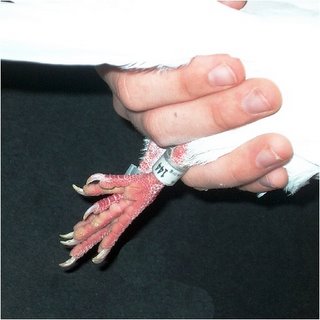Explaining WDRP Policy: Permanent Bands

There are several national pigeon racing organizations in existence: There is the American Racing Pigeon Union (ARPU); International Federation of Racing Pigeons (IF); the Canadian Racing Pigeon Union (CU), and more. These organizations are instrumental in administrating all sorts of things involving the keeping and raising of pigeons. They help keep records of racing clubs across the country, assist by offering educational materials, host pigeon races, lobby for racing pigeon-friendly laws on behalf of their membership, and more.
Just one of the things these organizations do is take orders from the clubs for bands. These bands are placed on the pigeons at about 5 to 7 days of age. They are slipped over one foot, and onto the pigeon's leg. The young bird grows so rapidly, the seamless band will never ever come off again -- thus, the pigeon has been given a sort of identification tag that will forever identify it in many ways.
The photograph shows a picture of a pigeon band from the American Racing Pigeon Union. You will notice many different letters and numbers on the band. Each of these pieces of information are helpful in indentifying that one individual bird.
- To begin with, each year the ARPU issues their bands in a different color. Unless specially ordered, all birds born in a given year will have a single color on their permanent bands, and that color, alone, identifies the year a pigeon was hatched. However, the year is also imprinted upon the band.
- There are letters to identify the club from which the bird came. This particular bird was bred by members of the WDRP group, thus the letters "WDRP" on the band.
- Following the letters, you might notice a series of numbers. These numbers, combined with the club i.d. letters, are unique: There is not another bird in the entire United States with those same letters and that same number on its band. Through some misfortune, if someone were to find the bird, they could easily track down the owner.
- There is usually a website address on the band.
To track the owner of a found bird, the appropriate information is on the internet through the ARPU website (or the appropriate club), or one can also call the pigeon organization for assistance.
For this particular bird in the picture, it has a WDRP band, but this particular band was custom ordered and has the website of the WDRP organization along the bottom of it.
Now that I've explained the letters and numbers of the bands, I can continue with their merit. There are other explanations for the bands in regards to the sport of pigeon racing. However, this entry pertains to the pigeons used for dove releases.
One purpose is to guard the integrity of the breeder. There are unethical people who many like to call "feather merchants." Their pigeon breeding "program" is the equivalent of a puppy mill. The breeders will breed many birds, purposefully not placing permanent bands on them, as the breeder would never want to be "found" when his birds are lost. A feather merchant sells his birds to whomever, whenever, for whatever, in the worst of circumstances. He does not want to be held to any level of accountability for his actions, thus no permanent bands.
The WDRP requires members to band their birds with permanent bands for identification purposes, because the members all care deeply about the "whereabouts" of their birds. Their birds are carefully trained, and are of quality breeding. However, in the very, very rare chance that a bird might become lost or injured somewhere, members want their birds back home safely. An identification band assists finders with the information they need to make the reunion of bird and caretaker a possibility.
An identification band also ascertains that birds are not being irresponsibly bred, as a breeder must be on top of his/her breeding program in order to get all birds banded during that critical period of growth where the young are not too small or too big for that band to slip on nicely, but not come off again.
Labels: American Racing Pigeon Union, ARPU, identification, IF, International Federation of Racing Pigeons, keeping pigeons, racing clubs, racing pigeons, raising pigeons, seamless band, tags, WDRP policy


0 Comments:
Post a Comment
<< Home